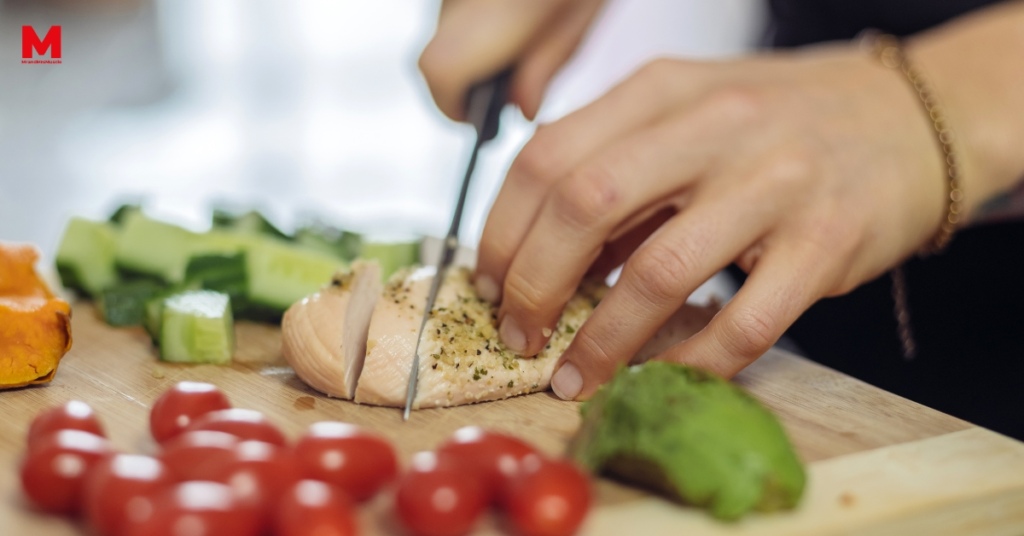Are you looking for an easy way to lose weight? Meal prepping for weight loss is a great way to make sure you’re eating healthy, nutritious meals that are tailored to help you reach your goals. Meal prepping is a simple process that allows you to make enough food ahead of time so that you have healthy meals and snacks available throughout the week. In this blog post, we’ll discuss how to meal prep for weight loss so that you can make the most of your efforts and reach your desired weight.
Benefits of Meal Prepping
Meal prepping has become increasingly popular over the years, especially for individuals who want to achieve their weight loss goals. The benefits of meal prepping are numerous, and some of the key ones include:
Saves Time:
Meal prepping allows you to prepare all your meals for the week in advance, so you don’t have to spend time every day cooking and preparing food. This is particularly helpful for people with busy schedules who don’t have the time to cook every day.
Saves Money:
Meal prepping allows you to buy ingredients in bulk, which is often cheaper than buying them individually. It also reduces the need for eating out or buying fast food, which can save you money in the long run.
– Portion Control:
Meal prepping allows you to control your portions and ensure you’re eating the right amount of food for your weight loss goals. This can be helpful for people who struggle with overeating or snacking throughout the day.
– Nutritional Value:
When you meal prep, you have control over what goes into your meals and can ensure that you’re getting all the necessary nutrients your body needs. This can be especially helpful for people who are following specific dietary restrictions or have food allergies.
Overall, meal prepping is an effective way to achieve your weight loss goals while also saving time, money, and ensuring you’re eating nutritious and healthy meals.
Setting Your Weight Loss Goals
Before starting your meal prep journey for weight loss, it’s important to set achievable goals. You want to avoid unrealistic goals that can discourage you if you don’t see immediate progress.
A good starting point is to calculate your daily caloric needs based on your age, gender, weight, and activity level. Once you have that number, you can aim to consume 500-1000 fewer calories per day to lose 1-2 pounds per week.
It’s also helpful to set a realistic timeline for your weight loss goals. Losing 1-2 pounds per week is a safe and sustainable rate of weight loss. Keep in mind that weight loss is not always linear and there may be weeks where you don’t see as much progress as you’d like. Don’t get discouraged, as long as you’re making progress towards your goal.
Finally, consider setting non-scale goals such as increasing your physical activity or trying new healthy recipes each week. These goals can help keep you motivated and focused on your overall health journey, rather than just a number on the scale.
Planning Your Meals
Once you’ve established your weight loss goals and identified the ingredients you’ll need, it’s time to plan your meals for the week.
Here’s how to get started:
1. Choose your recipes:
Look for recipes that are simple and quick to prepare, as this will make the meal-prepping process easier and more enjoyable. Choose a variety of recipes that align with your goals and dietary needs. This could include salads, soups, roasted veggies, stir-frys, and more.
2. Think about macronutrient balance:
Make sure your meals include a balance of protein, healthy fats, and complex carbs to keep you feeling satisfied and energized throughout the day.
3. Consider portion sizes:
Use an online calorie calculator or consult with a nutritionist to determine how many calories you should aim for each day. Then, divide that number by the number of meals and snacks you’ll have each day to figure out appropriate portion sizes. Some people prefer three main meals and two snacks per day, while others may prefer six smaller meals throughout the day.
4. Don’t forget snacks:
Planning healthy snacks is key to avoiding cravings and staying on track. Try prepping fruits and veggies with hummus, Greek yogurt with berries, or nuts and seeds.
5. Mix and match:
Once you’ve chosen your recipes, try mixing and matching ingredients to create variety and keep things interesting. For example, alternate between chicken, fish, and vegetarian options for your proteins, and mix up your vegetables by including a variety of colors.
Lastly, make a detailed list of all the ingredients you will need for each meal. This will help you stay organized during grocery shopping and prevent any last-minute trips to the store.
Grocery Shopping and Ingredient Prep
Once you have your meal plan in place, it’s time to hit the grocery store! This is a crucial step in the meal prep process, as it sets the foundation for healthy eating throughout the week. Here are some tips to make your grocery shopping and ingredient prep go smoothly:
1. Stick to Your List:
When you’re at the grocery store, it’s easy to get sidetracked by tempting treats and impulse buys. But if you’re serious about your weight loss goals, you need to stick to your list. Avoid the middle aisles of the store, where the processed foods and snacks are, and focus on fresh produce, lean protein, and healthy grains.
2. Buy in Bulk:
Purchasing ingredients in bulk can save you money in the long run, and it’s also more convenient for meal prep. Stock up on items like chicken breast, ground turkey, brown rice, and quinoa. You can also buy frozen vegetables and fruits in bulk to save time on prep.
3. Prep Your Ingredients:
Once you get home from the grocery store, it’s a good idea to prep your ingredients as much as possible. Wash and chop your veggies, portion out your protein, and cook your grains. This will make it easier to throw together meals throughout the week.
By following these tips, you’ll be well on your way to successful meal prep for weight loss. With a little bit of planning and organization, you can set yourself up for healthy eating all week long.
Batch Cooking and Portioning
Once you’ve finished grocery shopping and ingredient prep, it’s time to start cooking in batches and portioning your meals. Batch cooking refers to the process of cooking a large quantity of food at once and then portioning it out into individual meals. This is especially useful for those who have a busy schedule and limited time for cooking throughout the week.
First, choose which meals you’ll be cooking in batches. Some options could be grilled chicken breasts, roasted vegetables, or a pot of chili. Use containers that are microwave-safe and stackable for easy storage. Then, divide your meals into appropriate portion sizes to help with calorie control and staying within your weight loss goals.
When it comes to portioning, it’s important to use measuring tools such as a food scale or measuring cups. You can also use portion control containers or even a Sharpie marker to label the appropriate portions on your containers.
Once you’ve portioned your meals, make sure to label each container with the date and contents. This will help keep you organized and ensure that your meals are fresh.
Batch cooking and portioning are key components to successful meal prep. It saves time, ensures healthy choices, and helps with portion control for weight loss.
Storage and Organization
Once your meals are prepared and portioned, it’s important to properly store and organize them for easy access throughout the week. Here are some tips for effective storage and organization during your meal prep for weight loss:
1. Invest in good containers:
Make sure to use airtight and microwave-safe containers that are the right size for your portions. Glass containers are a great option as they are durable and can be easily cleaned.
2. Label and date your meals:
It’s important to know when your meals were prepared so you can consume them before they spoil. Label each container with the meal name and date.
3. Keep a designated area in your fridge and freezer:
Store your meals in one spot in your fridge and freezer so they are easy to find and you don’t accidentally forget about them.
4. Organize your meals by day or meal:
If you prefer to have your meals organized by day or meal (breakfast, lunch, dinner), use color-coded labels to differentiate them.
5. Pack your meals the night before:
If you’re someone who is always on the go, pack your meals the night before so you can quickly grab them in the morning and head out the door.
Proper storage and organization can save you time and keep you on track with your weight loss goals. With these tips, you’ll have a successful meal prep routine in no time!
Tips and Tricks for Successful Meal Prep
1. Start Small:
If you’re new to meal prepping, don’t overwhelm yourself by trying to prep an entire week’s worth of meals right away. Start with prepping just a few meals or snacks at a time until you get the hang of it.
2. Invest in Quality Containers:
Having the right containers can make all the difference when it comes to meal prep. Look for containers that are BPA-free, microwave-safe, and have compartments to keep your different foods separate and fresh.
3. Mix Up Your Recipes:
Don’t get stuck in a rut with the same meals week after week. Mix things up by trying new recipes and experimenting with different flavors and ingredients. This will keep you excited about your meals and prevent you from getting bored.
4. Utilize Your Freezer:
Don’t forget about the power of your freezer. Many meals and ingredients can be prepped in advance and frozen for later use. This can be a lifesaver on busy days when you don’t have time to cook from scratch.
5. Make Use of Leftovers:
Don’t let leftovers go to waste. Use them as a starting point for your meal prep by incorporating them into new dishes. For example, leftover grilled chicken can be chopped up and added to salads or wraps.
6. Get the Right Tools:
Invest in kitchen tools that will make your meal prep easier and more efficient. A good quality knife, cutting board, and food processor can all make a big difference in how quickly you can prep your ingredients.
7. Stay Organized:
Keep a meal prep calendar or schedule to help you stay on track and know what needs to be prepped each day. Also, label your containers with the date and contents so you know what’s inside and how long it has been stored.
By following these tips and tricks, you can set yourself up for successful and stress-free meal prep for weight loss. Remember to be patient with yourself and give yourself grace as you learn and adapt to this new routine.


